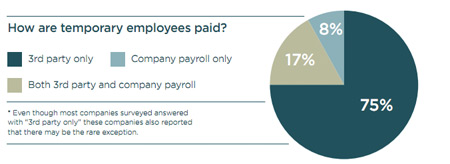Benchmarking Study on Use of Temporary Employees
The Situation
How “temporary” are your temporary employees? Does your company measure ‘temporary’ in days, weeks, months or years? The corporate office of one of America’s largest quick-service restaurants was experiencing a sharp increase in its ratio of temporary to regular employees. At the company’s current hiring rate, in 10 years, there would be one temporary employee for every two regular employees. That was an alarming trend for many reasons, but the most immediate concern was the impact to its very tight-knit and celebrated culture. Temporary employees—some with the company for as many as five years—were feeling like the “have nots” in a sea of “haves.”
inTalent Consulting Group was engaged to complete a benchmarking study, including a review the different aspects of temporary staffing, tsuch as legal implications, financial impact, cultural nuances, potential changes, and how others were addressing these types of issues. Our team explored many different solutions, but several key executives were not convinced there was even a problem to be solved. This presented its own challenge, as the head of HR felt it was not only a significant issue, but also an urgent one.
The Challenges
Since federal and state laws do not dictate how long an employee can stay at your company without receiving non-mandated benefits (such as medical benefits and paid time off), companies have their own policies in place to mitigate risk. This complex “in between” employment status leaves some individuals seeking to right the imbalance through legal action. The Microsoft case is a great example: hundreds of temporary employees were awarded back benefits, costing the company millions in restitution and fines.
The inTalent Solution
inTalent’s team identified 12 participating companies, equal in size, location or culture, and began a dialogue with the leadership of Talent Acquisition and Strategy. We asked questions around policy, full-time and part-time ratios, process administration, benefits eligibility, and other topics of interest to our client. We found that many other companies were struggling with the same issues, despite legal cases setting precedents against the use of long-term temporary employees.
Some key findings from our study:
Hiring temporary employees is no longer a simple request forwarded to HR for sourcing. In some larger, more disciplined companies, hiring managers must establish a business plan and receive approval from Legal, HR and Compliance in order to establish temporary employee status.
While most companies are careful not to blur the line between temporary and regular employees, most struggle to maintain an inclusive culture, while dealing with issues such as which meetings and events to allow temporary employees to attend..
Third party vendor utilization was the overall approach and payment structure utilized by those participating in our benchmarking study.
The Result
The client received a final report which summarized key findings and recommendations gathered from benchmark organizations. As a result of our study, the HR leader was able to influence the internal discussion and was able to impact internal policy decisions already underway.
Additionally, participating organizations received an executive brief. As a participant in the inTalent survey stated, “We were very bad at keeping track of our temporary employees, especially during the early 2000’s. But, it just isn’t worth the risk to wake up and see our company’s name in the headlines for all the wrong reasons. We have—just in the past three years—radically changed our policies around temporary employees.”


